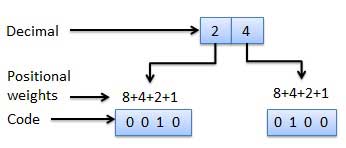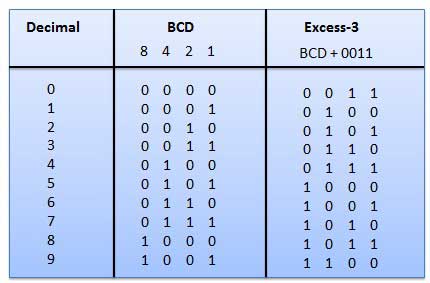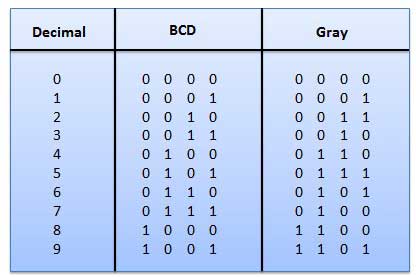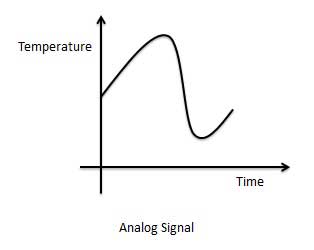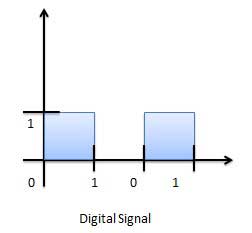There are many methods or techniques which can be used to convert code from one format to another. We'll demonstrate here the following
- Binary to BCD Conversion
- BCD to Binary Conversion
- BCD to Excess-3
- Excess-3 to BCD
Binary to BCD Conversion
Steps
Step 1 -- Convert the binary number to decimal.
Step 2 -- Convert decimal number to BCD.
Example − convert (11101)2 to BCD.
Step 1 − Convert to Decimal
Binary Number − 111012
Calculating Decimal Equivalent −
| Step | Binary Number | Decimal Number |
|---|---|---|
| Step 1 | 111012 | ((1 × 24) + (1 × 23) + (1 × 22) + (0 × 21) + (1 × 20))10 |
| Step 2 | 111012 | (16 + 8 + 4 + 0 + 1)10 |
| Step 3 | 111012 | 2910 |
Binary Number − 111012 = Decimal Number − 2910
Step 2 − Convert to BCD
Decimal Number − 2910
Calculating BCD Equivalent. Convert each digit into groups of four binary digits equivalent.
| Step | Decimal Number | Conversion |
|---|---|---|
| Step 1 | 2910 | 00102 10012 |
| Step 2 | 2910 | 00101001BCD |
Result
(11101)2 = (00101001)BCD
BCD to Binary Conversion
Steps
Step 1 -- Convert the BCD number to decimal.
Step 2 -- Convert decimal to binary.
Example − convert (00101001)BCD to Binary.
Step 1 - Convert to BCD
BCD Number − (00101001)BCD
Calculating Decimal Equivalent. Convert each four digit into a group and get decimal equivalent for each group.
| Step | BCD Number | Conversion |
|---|---|---|
| Step 1 | (00101001)BCD | 00102 10012 |
| Step 2 | (00101001)BCD | 210 910 |
| Step 3 | (00101001)BCD | 2910 |
BCD Number − (00101001)BCD = Decimal Number − 2910
Step 2 - Convert to Binary
Used long division method for decimal to binary conversion.
Decimal Number − 2910
Calculating Binary Equivalent −
| Step | Operation | Result | Remainder |
|---|---|---|---|
| Step 1 | 29 / 2 | 14 | 1 |
| Step 2 | 14 / 2 | 7 | 0 |
| Step 3 | 7 / 2 | 3 | 1 |
| Step 4 | 3 / 2 | 1 | 1 |
| Step 5 | 1 / 2 | 0 | 1 |
As mentioned in Steps 2 and 4, the remainders have to be arranged in the reverse order so that the first remainder becomes the least significant digit (LSD) and the last remainder becomes the most significant digit (MSD).
Decimal Number − 2910 = Binary Number − 111012
Result
(00101001)BCD = (11101)2
BCD to Excess-3
Steps
Step 1 -- Convert BCD to decimal.
Step 2 -- Add (3)10 to this decimal number.
Step 3 -- Convert into binary to get excess-3 code.
Example − convert (1001)BCD to Excess-3.
Step 1 − Convert to decimal
(1001)BCD = 910
Step 2 − Add 3 to decimal
(9)10 + (3)10 = (12)10
Step 3 − Convert to Excess-3
(12)10 = (1100)2
Result
(1001)BCD = (1100)XS-3
Excess-3 to BCD Conversion
Steps
Step 1 -- Subtract (0011)2 from each 4 bit of excess-3 digit to obtain the corresponding BCD code.
Example − convert (10011010)XS-3 to BCD.
Given XS-3 number = 1 0 0 1 1 0 1 0 Subtract (0011)2 = 0 0 1 1 0 0 1 1 -------------------- BCD = 0 1 1 0 0 1 1 1
Result
(10011010)XS-3 = (01100111)BCD


